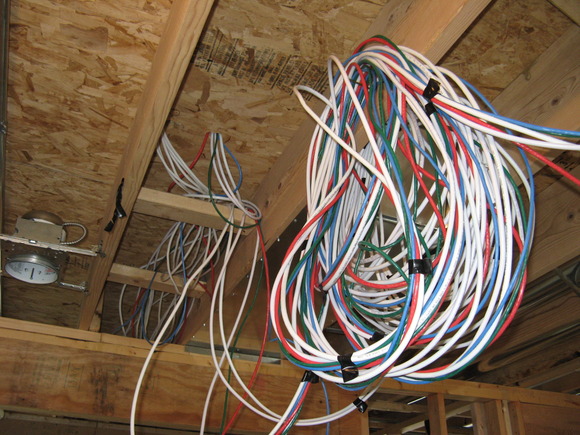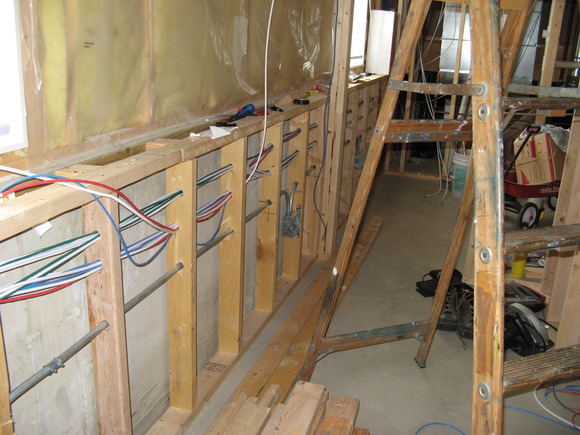beelzerob
Senior Member
Within a month, I'll be finally running the 14k ft of wire I'm about to purchase in and around the framing of my house. But I find myself needing to start preparing mentally for this challenge. Oh, and there are some technical questions too....
The builder and electrician are going to give me a short course in what I can and CAN'T drill through and otherwise how I run the wire, so I'm not looking for code-related hints necessarily....but I'm looking for tips from you guys that have done this...your little nuggets of wisdom that will make it slightly less painful than it is sure to be. So start with answering these questions, and then add whatever other tips you can.
(What I've learned)
1) If I need 1000 ft of some type of wire, but most or all of my runs require 2 of that kind of wire....would it be better to buy 2 X 500 ft boxes of wire instead so I can run both wires as the same time?
Yes, it will be easier to be able to pull from individual boxes for a single run. So if you have runs that require 2 RG6, then 2 500ft boxes are better than 1 1000ft box. Smaller sizes of wire will probably cost you more per foot, though.
2) All wiring is going to the same location in the basement. Is it better to start all wiring runs from the basement and thread it to the target location, or do I start up there and work down.....or does it matter?
It's a matter of preference. If you run from upstairs down, then at least you're not working against gravity. However, if all of your runs terminate in one location (the basement), then pulling from that location means not having to move your boxes of cable all around the house.
3) Do I run just 1 wire at a time? Do I tie or tape wires together and run it like a big cable?
Run as many wires as you can in a single pull. So, if you have 2 RG6 and 2 Cat5 all coming from one location, then take those 4 wires and use electrical tape or velcro and join them together into one monster type cable and pull that through. Note that if you have 12 RG6QS wires in a single pull, you probably will not be able to fit that through any hole your studs could handle...maybe 3 runs of 4 wires each then.
4) Do I work on 1 room at a time, or 1 wire type at a time?
Since in most cases, a single run of wire may consist of several different wire types, it's usually better to do 1 room at a time.
5) Do I work 1 wire all the way through before starting another, or do I start several wires before moving to the next floor and continuing them on?
Better efficiency is achieved by getting as much wire as possible ready to be pulled on the next floor. Hours would be lost just going from 1 floor to the next pulling a single wire at a time. However, make sure that staging a lot of wires at the same point for pulling doesn't cause them to tangle while you're trying to pull them from the next floor.
6) Do you ever cut a wire to length before running it through where it goes? (assuming you somehow believe you know how long the wire is supposed to be)
To be avoided at all costs. It'll suck when you're a foot short. A better plan is to have enough cable sources so you can pull the cables all at the same time from individual boxes.
7) Should wires always come down from the ceiling, or can they come up from the floor (to halfway up the wall, for instance).
Whichever works, and whichever keeps them further away from HV wires. A common practice on 2 story houses is to run all of the 2nd floor wires up through the ceiling to a low-voltage "super-highway" conduit which goes straight down to the basement.
8) Try to stay 4 ft away from HV lines, and if you do have to cross over them, do it at a right angle.....RIGHT?
4' will be next to impossible. Instead, just don't share the same stud cavity if at all possible. And yes, right angle crossings when required.
Ok, that's a start....I'll have more questions no doubt as you guys answer. thanks for the help!
The builder and electrician are going to give me a short course in what I can and CAN'T drill through and otherwise how I run the wire, so I'm not looking for code-related hints necessarily....but I'm looking for tips from you guys that have done this...your little nuggets of wisdom that will make it slightly less painful than it is sure to be. So start with answering these questions, and then add whatever other tips you can.
(What I've learned)
1) If I need 1000 ft of some type of wire, but most or all of my runs require 2 of that kind of wire....would it be better to buy 2 X 500 ft boxes of wire instead so I can run both wires as the same time?
Yes, it will be easier to be able to pull from individual boxes for a single run. So if you have runs that require 2 RG6, then 2 500ft boxes are better than 1 1000ft box. Smaller sizes of wire will probably cost you more per foot, though.
2) All wiring is going to the same location in the basement. Is it better to start all wiring runs from the basement and thread it to the target location, or do I start up there and work down.....or does it matter?
It's a matter of preference. If you run from upstairs down, then at least you're not working against gravity. However, if all of your runs terminate in one location (the basement), then pulling from that location means not having to move your boxes of cable all around the house.
3) Do I run just 1 wire at a time? Do I tie or tape wires together and run it like a big cable?
Run as many wires as you can in a single pull. So, if you have 2 RG6 and 2 Cat5 all coming from one location, then take those 4 wires and use electrical tape or velcro and join them together into one monster type cable and pull that through. Note that if you have 12 RG6QS wires in a single pull, you probably will not be able to fit that through any hole your studs could handle...maybe 3 runs of 4 wires each then.
4) Do I work on 1 room at a time, or 1 wire type at a time?
Since in most cases, a single run of wire may consist of several different wire types, it's usually better to do 1 room at a time.
5) Do I work 1 wire all the way through before starting another, or do I start several wires before moving to the next floor and continuing them on?
Better efficiency is achieved by getting as much wire as possible ready to be pulled on the next floor. Hours would be lost just going from 1 floor to the next pulling a single wire at a time. However, make sure that staging a lot of wires at the same point for pulling doesn't cause them to tangle while you're trying to pull them from the next floor.
6) Do you ever cut a wire to length before running it through where it goes? (assuming you somehow believe you know how long the wire is supposed to be)
To be avoided at all costs. It'll suck when you're a foot short. A better plan is to have enough cable sources so you can pull the cables all at the same time from individual boxes.
7) Should wires always come down from the ceiling, or can they come up from the floor (to halfway up the wall, for instance).
Whichever works, and whichever keeps them further away from HV wires. A common practice on 2 story houses is to run all of the 2nd floor wires up through the ceiling to a low-voltage "super-highway" conduit which goes straight down to the basement.
8) Try to stay 4 ft away from HV lines, and if you do have to cross over them, do it at a right angle.....RIGHT?
4' will be next to impossible. Instead, just don't share the same stud cavity if at all possible. And yes, right angle crossings when required.
Ok, that's a start....I'll have more questions no doubt as you guys answer. thanks for the help!



